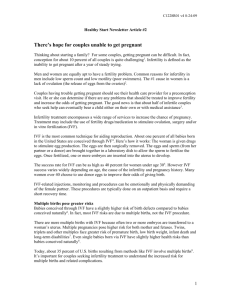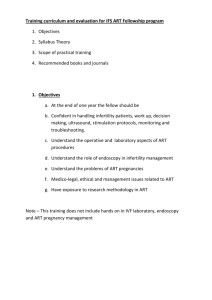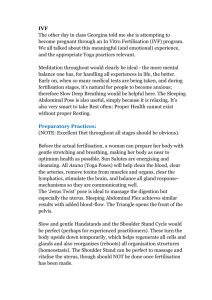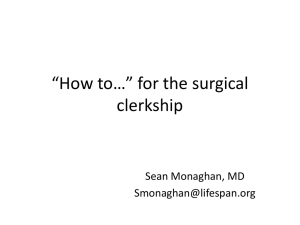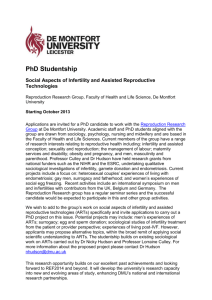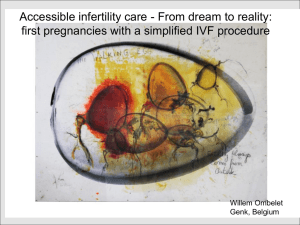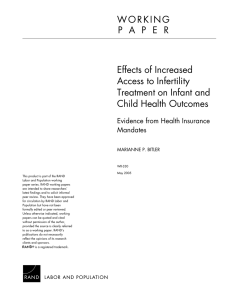(merits file, volume VI, folio 2828). As expert witness Zegers
advertisement
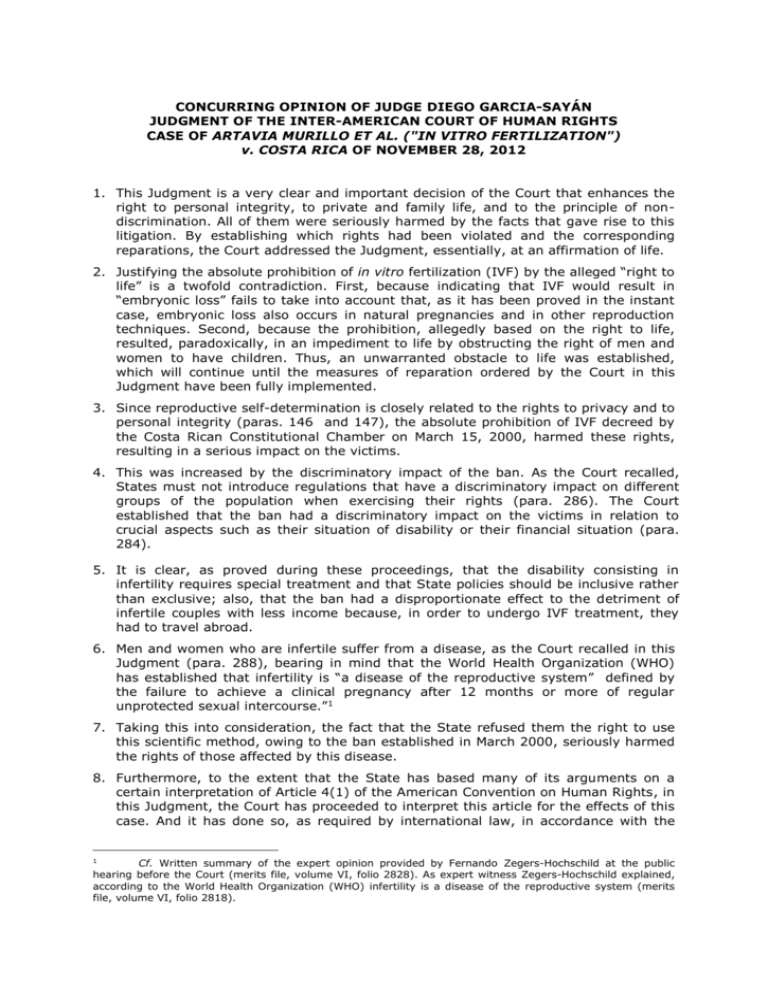
CONCURRING OPINION OF JUDGE DIEGO GARCIA-SAYÁN JUDGMENT OF THE INTER-AMERICAN COURT OF HUMAN RIGHTS CASE OF ARTAVIA MURILLO ET AL. ("IN VITRO FERTILIZATION") v. COSTA RICA OF NOVEMBER 28, 2012 1. This Judgment is a very clear and important decision of the Court that enhances the right to personal integrity, to private and family life, and to the principle of nondiscrimination. All of them were seriously harmed by the facts that gave rise to this litigation. By establishing which rights had been violated and the corresponding reparations, the Court addressed the Judgment, essentially, at an affirmation of life. 2. Justifying the absolute prohibition of in vitro fertilization (IVF) by the alleged “right to life” is a twofold contradiction. First, because indicating that IVF would result in “embryonic loss” fails to take into account that, as it has been proved in the instant case, embryonic loss also occurs in natural pregnancies and in other reproduction techniques. Second, because the prohibition, allegedly based on the right to life, resulted, paradoxically, in an impediment to life by obstructing the right of men and women to have children. Thus, an unwarranted obstacle to life was established, which will continue until the measures of reparation ordered by the Court in this Judgment have been fully implemented. 3. Since reproductive self-determination is closely related to the rights to privacy and to personal integrity (paras. 146 and 147), the absolute prohibition of IVF decreed by the Costa Rican Constitutional Chamber on March 15, 2000, harmed these rights, resulting in a serious impact on the victims. 4. This was increased by the discriminatory impact of the ban. As the Court recalled, States must not introduce regulations that have a discriminatory impact on different groups of the population when exercising their rights (para. 286). The Court established that the ban had a discriminatory impact on the victims in relation to crucial aspects such as their situation of disability or their financial situation (para. 284). 5. It is clear, as proved during these proceedings, that the disability consisting in infertility requires special treatment and that State policies should be inclusive rather than exclusive; also, that the ban had a disproportionate effect to the detriment of infertile couples with less income because, in order to undergo IVF treatment, they had to travel abroad. 6. Men and women who are infertile suffer from a disease, as the Court recalled in this Judgment (para. 288), bearing in mind that the World Health Organization (WHO) has established that infertility is “a disease of the reproductive system” defined by the failure to achieve a clinical pregnancy after 12 months or more of regular unprotected sexual intercourse.”1 7. Taking this into consideration, the fact that the State refused them the right to use this scientific method, owing to the ban established in March 2000, seriously harmed the rights of those affected by this disease. 8. Furthermore, to the extent that the State has based many of its arguments on a certain interpretation of Article 4(1) of the American Convention on Human Rights, in this Judgment, the Court has proceeded to interpret this article for the effects of this case. And it has done so, as required by international law, in accordance with the Cf. Written summary of the expert opinion provided by Fernando Zegers-Hochschild at the public hearing before the Court (merits file, volume VI, folio 2828). As expert witness Zegers-Hochschild explained, according to the World Health Organization (WHO) infertility is a disease of the reproductive system (merits file, volume VI, folio 2818). 1 ordinary meaning given to the terms, as well as with a systematic and historical interpretation and one that corresponds to the object and purpose of the treaty, using as supplementary means of interpretation the preparatory work of this article of the Convention. 9. The Court’s interpretation and the available scientific evidence led, among other consequences, to the conclusion that it cannot be determined that Article 4(1) seeks to confer the status of “person” on the embryo, emphasizing that “… the tendencies of regulations under international law do not lead to the conclusion that the embryo should be treated in the same way as a person …” (para. 253). 10. The reparations have been established not only directly with regard to the persons declared victims. They also establish measures addressed at society as a whole, such as those concerning non-repetition, and specific guidelines to create the appropriate conditions to ensure compliance with the State’s duty to comply with the obligations set out in the Judgment with regard to personal integrity, private and family life, and the principle of non-discrimination. 11. The essence of the measures of reparation is, therefore, that the State must not only cease creating discriminatory regulations and practices, but that it must also annul the prohibition and gradually facilitate the use of this reproduction technique to those who need and want it. In this regard, the Court basically establishes, inter alia, three precise lines of action designed to constitute guarantees of non-repetition and to ensure that the conduct of the State is in keeping with its international obligations: a) The first is that the State must “take the appropriate measures to annul as rapidly as possible the prohibition to practice IVF and so that the persons who wish to use this assisted reproduction technique can do so without any impediment” (para. 336). Thus, the State must adopt promptly the necessary measures, within its own institutional framework, to ensure that the prohibition is annulled; b) The second is that the State must “regulate any aspects of the implementation of IVF that it considers necessary” (para. 337), which refers to regulations to be drafted and implemented by the State to ensure that this technique is used correctly by qualified institutions and professionals; c) The establishment, in the third measure, that social security must gradually include “the availability of IVF within its health care infertility programs and treatments, in accordance with the obligation of guarantee in relation to the principle of non-discrimination” (para. 338) is designed to ensure that the said technique is included gradually in the programs to treat infertility that are already offered. This does not mean that a disproportionate percentage of social security’s institutional and budgetary resources should be devoted to this purpose, to the detriment of other programs and priorities, but is intended to ensure that this service is made available progressively. It should be emphasized that this order of the Court is clearly and directly related to the principle of non-discrimination. Thus, it cannot be understood as an order that leads to situations of inequality. Consequently, regarding the said gradualness, it should be stressed that the Committee on Economic, Social and Cultural Rights2 has indicated that the “precise nature” of the available health services and programs “will vary depending on numerous factors, including the State party’s developmental level.” This Committee has also indicated that one of the components of accessibility without discrimination to health services is related to “economic accessibility Committee on Economic, Social and Cultural Rights, General Comment 14 (2000): The right to the highest attainable standard of health (article 12 of the International Covenant on Economic, Social and Cultural Rights), E/C.12/2000/4, 11 August 2000, para. 12.a) 2 2 (affordability),” so that health facilities, goods and services must be affordable for all. The Committee has added that the payment for health-care services “has to be based on the principle of equity, ensuring that these services, whether privately or publicly provided, are affordable for all, including socially disadvantaged groups. Equity demands that poorer households should not be disproportionately burdened with health expenses as compared to richer households.”3 These considerations allow me to stress the causal nexus of the order issued by the Court in relation to the particular situation of persons whose only possibility of procreation is access to IVF and who do not have the financial resources to access this type of assisted reproduction technique. In addition, as revealed by the answer to the submission of the case and the final arguments of the State of Costa Rica, the State has medical programs and services that offer different treatments for infertility problems, including assisted reproduction techniques. The State advised that the only method excluded from the public programs to treat reproductive health problems has been IVF, owing to the ruling of the Constitutional Chamber. Thus, it is possible to relate the exclusion of IVF to the arguments developed in the judicial decision analyzed in this Judgment, and it is not evident that it was economic or budgetary considerations that justified the said exclusion. In addition, it was not proved that a situation existed, such as that of other States, in which the inexistence or insufficiency of resources to subsidize part of the access to assisted reproduction techniques has been alleged. Thus the State must continue making gradual progress to guarantee, without discrimination, access to the adequate and necessary treatments to deal with different forms of infertility. In this regard, I would stress that the Court’s mandate is not addressed at modifying any type of prioritization at the domestic level, in the understanding that access to assisted reproduction techniques had already been incorporated into the comprehensive care provided by the State. The Court, as is its consistent practice, leaves in the hands of the local authorities the series of decision on the nature and scope of the measures required to guarantee, progressively, whatever is pertinent in relation to the series of techniques associated with the different methods of IVF and, to this end, the authorities must implement the specific and necessary regulations. 12. Bearing in mind that the main fact that gave rise to this litigation was the prohibition of an assisted reproduction technique – IVF – in Costa Rica, this Judgment not only establishes which articles of the Convention have been violated and the corresponding reparations. In essence and based on its content, it makes a fundamental contribution to life as expressed by the more than five million people who today enjoy life because their parents used this type of method to counter infertility, and who would not exist if it had not been for this method. Diego García-Sayan Judge Pablo Saavedra Alessandri Secretary Committee on Economic, Social and Cultural Rights, General Comment 14 (2000): The right to the highest attainable standard of health (article 12 of the International Covenant on Economic, Social and Cultural Rights), E/C.12/2000/4, 11 August 2000, para. 12.b.iii) 3 3 Judge Rhadys Abreu Blondet adhered to this Opinion of Judge Diego García-Sayán. Rhadys Abreu Blondet Judge Pablo Saavedra Alessandri Secretary 4
